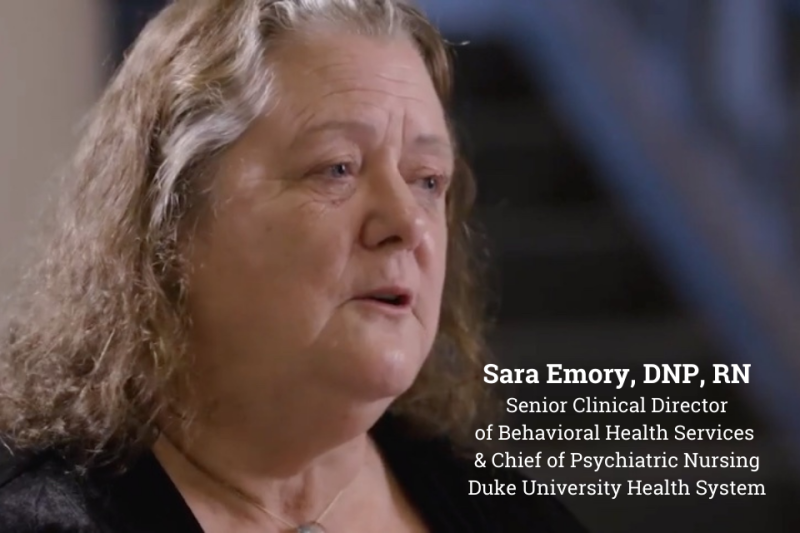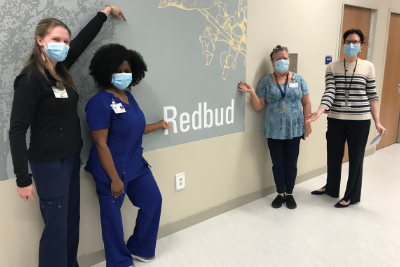
Sara Emory, DNP, RN, recalls that even as a young child, she would wonder what people were going through that would prompt them to act in certain ways—an early sign of her concern for others and a seed that blossomed into a career of more than 41 years in psychiatric nursing.
Emory, who started at Durham Regional Hospital—now Duke Regional Hospital—in 1986, is the senior clinical director of behavioral health services and chief of psychiatric nursing for the Duke University Health System.
“I interface with any area within the health system that is struggling with how to approach patient behavior,” she says. “And I help develop strategies and programs to assist nurses in caring for patients based on their behaviors.” She also supervises all non-physician behavioral clinicians, including nurses, social workers, licensed professional counselors and recreational therapists.
Emory leveraged the knowledge and insights she gained through her decades-long career working with behavioral health patients to help conceptualize the new Duke Behavioral Health Center North Durham at Duke Regional Hospital, which opened last month.
In honor of Mental Health Awareness Month, we talked with Emory about what makes the new center so special, how we can promote mental health awareness and decrease stigma against mental illness, and what drives her passion for her work. Below are some key excerpts from our conversation, edited for length.
What excites you most about the new behavioral health center?
In the past, many of our spaces have been medical facilities that people attempted to remodel to make more tolerable for the treatment of people with behavioral health issues. Their intentions were good, but their efforts often fell short because they didn’t think about how these patients would actually use the space. Let me give you a couple of examples of how this new center is different.
There are two outdoor courtyards: the meditative courtyard, set up for groups of two or three people to sit and gather, and the active courtyard, which is set up to be a space where people can comfortably walk. When someone is pacing in a circle due to limited space, they’re never relaxed. That’s why we intentionally made the active courtyard long—so the walking path is more of an oval shape.
On the first day the inpatients moved in, I escorted patients to the meditative courtyard after lunch. They were playing cards, and they enjoyed that. It allowed people to be in smaller groups within the larger group, and that’s often very reassuring to people. We had patients who didn’t feel comfortable talking with the others, but they still wanted to be close to the group, so they had the option to select a different bench.
One of the patients started walking around the courtyard, but in that space, he was limited to a small circular path, so I took him to the other, larger outdoor space. And as he walked out, he turned and looked at me with tears in his eyes, and he said, “It’s elliptical!” He took his shoes off, and he started walking—and he was so happy.
I tell this story because I want people to understand that the space really impacts people’s perceptions of what’s going on and how they view their life. The physical plan of the new center is set up to engage people with each other and with their environment. There’s a ton of sunlight, you have access to the outdoors, and you can see the sky and the clouds through the special, clear safety windows—just like if you were looking through your windows at home.

Another thing I love about the new building is that, in the inpatient area, we refer to the different sections as neighborhoods, and they’re each named after a North Carolina tree. And we did that because it mirrors how we live in neighborhoods in our community. We tried very hard to make sure that, as much as possible, the space doesn’t feel institutional. We designed it to be a place where you live and you go about your business, just like you’ll be doing when you return to your home community.
What’s one thing you'd like people to know about mental illness?
A mental illness is treatable and can be managed as any other health condition. What you need is a good treatment approach and plan, plus a strong support system.
I think one of the biggest impacts we can have is on the individual’s belief about what their world is going to be like in the future. Many people come in believing their world has ended, because they don’t have any idea how they’re going to respond to treatment and be able to manage their diagnosis.
Think about the fact that some of the behavioral health disorders can be described as “severe and persistent mental illness.” By choosing to name it that way, you’re essentially saying to somebody, “There’s something really wrong with you, and it’s always going to be there.” And compare that to how people talk to someone when they have hypertension: “If you change your diet, if you sleep well, etc., you’re going to be able to manage this much better.” But when you have a thought disorder or emotional disorder, with good treatment, along with eating better, exercising and sleeping well, you’re going to manage that condition better, too.
For so long, people have separated the two, but they’re not different. That’s where I really want to have an impact—I don’t want people to leave the facility believing they have to give up their dreams for the future. And that’s a fundamental shift in approach.
What are some things people in the community can do to promote mental health awareness and decrease stigma?
One thing people can do to erase stigma is to be really conscious of the language they use. Every time you hear yourself say you’re depressed when you’re actually just sad—stop. Every time you hear yourself say, “There’s got to be something wrong with that person”—stop. Because when you say a person is wrong, what are you saying about them?
We also need to stop making assumptions that when something bad happens, the person responsible has a mental illness. For example, almost without fail, when you hear about mass shooters, one of the first things people say is that the person has a mental illness. And they may not have a mental illness—there may be other factors that explain this horrible event.
How do you think the new behavioral health center will improve the care we provide to our patients?
There are three things we really want to focus on:
- Getting people involved in the community before they’re discharged, so transitioning patients out of the hospital with a smooth process that connects them with their next phase of care and support systems. We want people to feel connected and to know they’re working towards going home.
- Tailoring patients’ therapies to match their goals for when they’re living in the community. So, for example, if a patient tells me they want to be a deejay, we’d talk about what steps might be needed to achieve that goal and ensure that their outpatient treatment plan will support that goal. Most importantly, we also focus on addressing our patients’ most distressing symptoms, but we want to build in the additional layer to help them achieve the best functioning for their life goals.
- Training our future providers—and that includes psychiatry residents and fellows, psychology interns, and pharmacy, physician assistant, nursing, recreational therapy and social work students. It’s important to us to provide quality care, but we want to make sure we’re reaching beyond the people who come to see us. We want to help train the next generation of providers to share the wealth.
What drives your passion for your work?
I don’t want to leave anyone afraid or alone. I don’t want people forgotten or overlooked. And I have a fundamental belief that people are not their illness, that every single person has something unique and valuable to offer to the world, and that we should invest in helping them be who they want to be.
People are beautiful and fascinating and wonderful, and sometimes I think they just get so down on themselves. I want to be the one that says, “I’m not going to leave you in that place, and however long it takes, we’ll get past this.” I think most of us who work in this field, that’s what we believe, and that’s what we want to do. And sometimes just that belief is enough to help somebody keep moving forward.